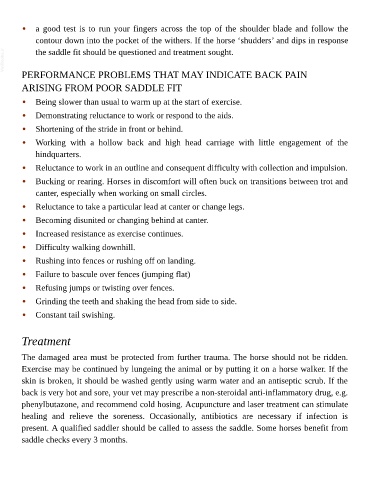Page 872 - The Veterinary Care of the Horse
P. 872
• a good test is to run your fingers across the top of the shoulder blade and follow the
contour down into the pocket of the withers. If the horse ‘shudders’ and dips in response
VetBooks.ir the saddle fit should be questioned and treatment sought.
PERFORMANCE PROBLEMS THAT MAY INDICATE BACK PAIN
ARISING FROM POOR SADDLE FIT
• Being slower than usual to warm up at the start of exercise.
• Demonstrating reluctance to work or respond to the aids.
• Shortening of the stride in front or behind.
• Working with a hollow back and high head carriage with little engagement of the
hindquarters.
• Reluctance to work in an outline and consequent difficulty with collection and impulsion.
• Bucking or rearing. Horses in discomfort will often buck on transitions between trot and
canter, especially when working on small circles.
• Reluctance to take a particular lead at canter or change legs.
• Becoming disunited or changing behind at canter.
• Increased resistance as exercise continues.
• Difficulty walking downhill.
• Rushing into fences or rushing off on landing.
• Failure to bascule over fences (jumping flat)
• Refusing jumps or twisting over fences.
• Grinding the teeth and shaking the head from side to side.
• Constant tail swishing.
Treatment
The damaged area must be protected from further trauma. The horse should not be ridden.
Exercise may be continued by lungeing the animal or by putting it on a horse walker. If the
skin is broken, it should be washed gently using warm water and an antiseptic scrub. If the
back is very hot and sore, your vet may prescribe a non-steroidal anti-inflammatory drug, e.g.
phenylbutazone, and recommend cold hosing. Acupuncture and laser treatment can stimulate
healing and relieve the soreness. Occasionally, antibiotics are necessary if infection is
present. A qualified saddler should be called to assess the saddle. Some horses benefit from
saddle checks every 3 months.

